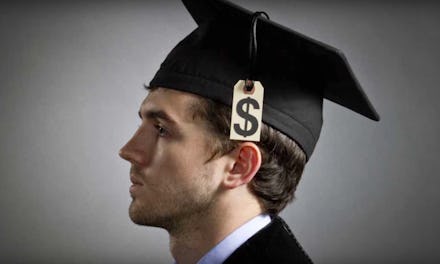Private Student Loans vs Government Student Loans: One Could Save You From Crippling Debt

College is expensive AF, and as tuition continues to soar, so does students' reliance on loans to cover the cost of education. While students without full scholarships and/or purse-strings do have the option of applying for financial aid and federally subsidized Stafford loans. However, there are limitations to how much you can be awarded and borrow, and, more to the point, the grants and borrowed money still might not be enough to pay for your education. Short of dropping out of school, students then have the option of applying for private student loans, but agreeing to the terms often feels like making a deal with the devil.
Read more: 4 Ways to Get out of Debt When You're a Broke AF Millennial
Stafford Loans
The U.S. Department of Education provides loans to any eligible student matriculated at least half-time at an accredited four-year college or university, two-year community college or vocational school. Government loans are considered better because the interest rates are not only fixed, but fixed at a low interest rate. The lower the interest rate, the less you'll have to pay back in addition to the amount you borrow.
Subsidized vs. Unsubsidized
The interest for a subsidized Stafford loan is paid for by the U.S. government while you're still enrolled in school. If you fall below half-time status, or when you graduate, you have a six-month grace period before you have to start making repayments.
Subsidized loans are available only to undergraduates with demonstrated financial need, while unsubsidized loans are available to both undergraduate and graduate students. The interest on unsubsidized loans, while just as low as subsidized loans, are not paid for while you're enrolled in school; if you don't make any payments, you will accrue interest, and you'll wind up paying more overall.
Private Loans
In comparison to Stafford loans, private loans feel reprehensibly punitive. Unlike federal loans, private loans are provided by banks and credit unions, who really have no incentive to keep interest rates low or fixed; instead, interest rates for private loans can be variable, and can exceed 18%. Many private loans also require repayment while you're still in school (or rather: it would prove wise to make minimum payments, as private loans are unsubsidized). Many private loans also require a cosigner, which means both you and your cosigner's credit is factored. Finally, most private loans do not offer deferments or loan-forgiveness and they cannot be consolidated, which ultimately limits the ways you can go about settling your debt.
In short: private loans might help you settle your tuition in the interim, but they can completely screw up your finances down the road — you might be paying nearly double of what you originally borrowed.